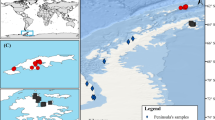Abstract
Clonal structure of a population of Macrotrachela quadricornifera (Rotifera, Bdelloidea) from a terrestrial moss in Northern Italy, was investigated over a 16 month period. Every month, 40–60 specimens of M. quadricornifera were collected from about 0.1 m2 of moss. The individual animals were homogenized and their isozyme phenotypes analyzed by electrophoresis on vertical polyacrylamide gel. One enzyme, phosphoglucose isomerase (PGI), was used as a marker to distinguish the different clones present in the sample. A few clones were established from the rotifers sampled and patterns of esterases α and β, and malic enzyme were studied. Nine electrophoretic patterns for PGI were seen. One was dominant, a second was almost always present, but in lesser amounts. The remainder were present occasionally.
There seemed to be no seasonal replacement of the clones and the composition of the population appeared to be unaffected by variations in temperature. Relative humidity seemed to be the more important factor in regulating the number of electromorphs of the rotifer population.
Access this chapter
Tax calculation will be finalised at checkout
Purchases are for personal use only
Preview
Unable to display preview. Download preview PDF.
Similar content being viewed by others
References
Bartos, E., 1951. The Czechoslovak Rotatoria of the Order Bdelloidea. Vestnik Cs. Zool. spol. 15: 241–500.
Carvalho, G. R., 1987. The clonal ecology of Daphnia magna (Crustacea: Cladocera). I. Temporal changes in the clonal structure of a natural population. J. anim. Ecol. 56: 453–468.
Dobers, E., 1915. Uber die Biologie der Bdelloidea. Int. Revue ges. Hydrobiol. Hydrol. Suppl. zu Bd. 7: 1–128.
Donner, J., 1965. Ordnung Bdelloidea. Akademie Verlag. 297 pp.
Harris, H. & D. A. Hopkinson, 1976. Handbook of enzyme electrophoresis in human genetics. North-Holland, Amsterdam, Neth.
Hebert, P. D. N., 1977. Niche overlap among species in the Daphnia carinata complex. J. anim. Ecol. 46: 399–409.
Hebert, P. D. N. & T. J. Crease, 1980. Clonal coexistence inDaphnia pulex (Leydig): another planktonic paradox. Science 207: 1363–1365.
Hebert, P. D. N. & T. J. Crease, 1983. Clonal diversity in populations of Daphnia pulex reproducing by obligate parthenogenesis. Heredity 51: 353–369.
Hebert, P. D. N. & C. Moran, 1981. Enzyme variability in natural populations of Daphnia cannata King. Heredity 45: 313–321.
King, C. E., 1977. Genetics of reproduction, variation, and adaptation in rotifers. Arch. Hydrobiol. Ergeb. Limnol. 8: 187–201.
King, C. E., 1980. The genetic structure of zooplankton populations, p. 315–328. In: W. C. Kerfoot (ed.), Evolution and ecology of zooplankton communities. Univ. Press New England, Hanover.
King, C.E. & Y. Zhao, 1987. Coexistence of rotifer (Brachionus plicatilis) clones in Soda Lake, Nevada. Hydrobiologia 147: 57–64.
Korpelainen, H., 1986. Competition between clones: an experimental study in a natural population of Daphnia magna. Hereditas 105: 29–35.
Loaring, J. M. & P.D.N. Hebert, 1981. Ecological differences among clones of Daphnia pulex Leydig. Oecologia 51: 162–168.
Lynch, M., 1984. The genetic structure of a cyclical parthenogen. Evolution 38: 186–203.
Morgan, C. I., 1977. Population dynamics of two species of Tardigrada, Macrobiotus hufelandii (Schultze) and Echiniscus (Echiniscus) testudo (Doyere), in roof moss from Swansea. J. anim. Ecol. 46: 263–279.
Parker, E. D., Jr., 1979. Ecological implications of clonal diversity in parthenogenetic morphospecies. Am. Zool. 19: 753–762.
Rossi, V. & Menozzi P. The clonal ecology of Heterocypris incongruens (Crustacea: Ostracoda). Ecology, in press.
Snell, T. W., 1977. Clonal selection: competition among clones. Arch. Hydrobiol. Ergeb. Limnol. 8: 202–204.
Snell, T. W., 1979. Interspecific competition and population structure in rotifers. Ecology 60: 494–502.
Weider, L. J., M. J. Beaton & P. D. N. Hebert, 1987. Clonal diversity in High-Artic populations of Daphnia pulex, a polyploid apomictic complex. Evolution 41: 1335–1346.
Young, J. P. W., 1979. Enzyme polymorphism and cyclic parthenogenesis in Daphnia magna. I. Selection and clonal
Author information
Authors and Affiliations
Editor information
Editors and Affiliations
Rights and permissions
Copyright information
© 1989 Kluwer Academic Publishers
About this paper
Cite this paper
Ricci, C., Pagani, M., Bolzern, A.M. (1989). Temporal analysis of clonal structure in a moss bdelloid population. In: Ricci, C., Snell, T.W., King, C.E. (eds) Rotifer Symposium V. Developments in Hydrobiology, vol 52. Springer, Dordrecht. https://doi.org/10.1007/978-94-009-0465-1_17
Download citation
DOI: https://doi.org/10.1007/978-94-009-0465-1_17
Publisher Name: Springer, Dordrecht
Print ISBN: 978-94-010-6694-5
Online ISBN: 978-94-009-0465-1
eBook Packages: Springer Book Archive




